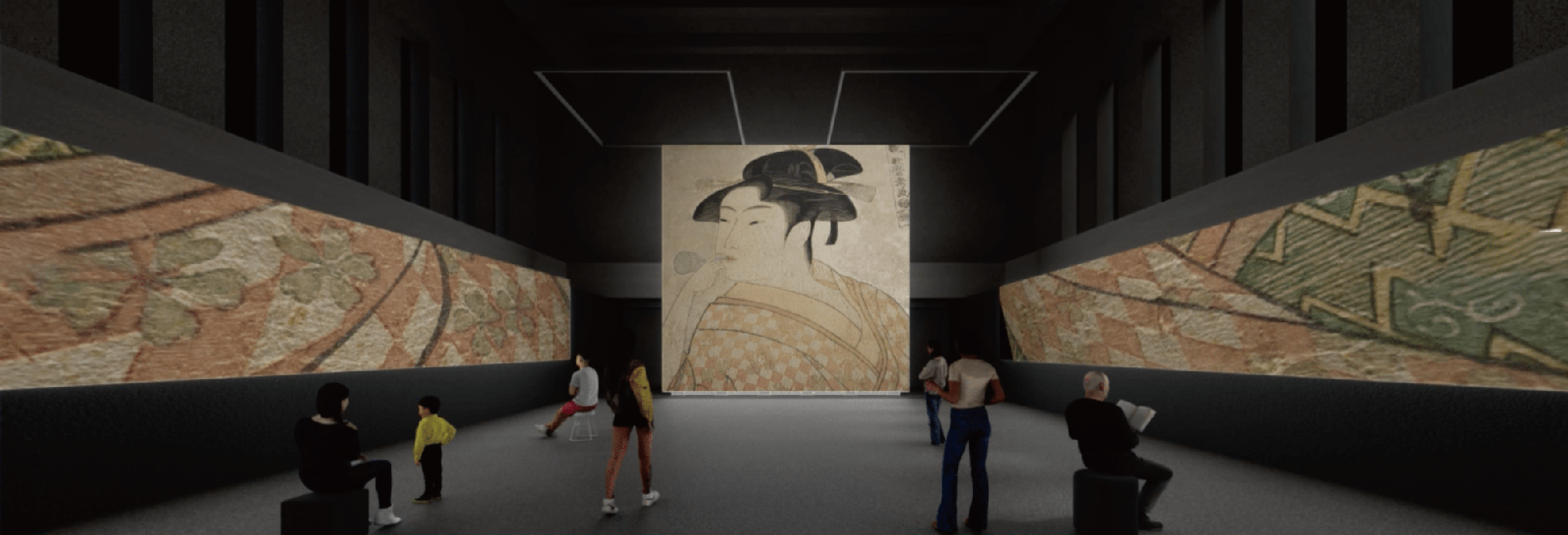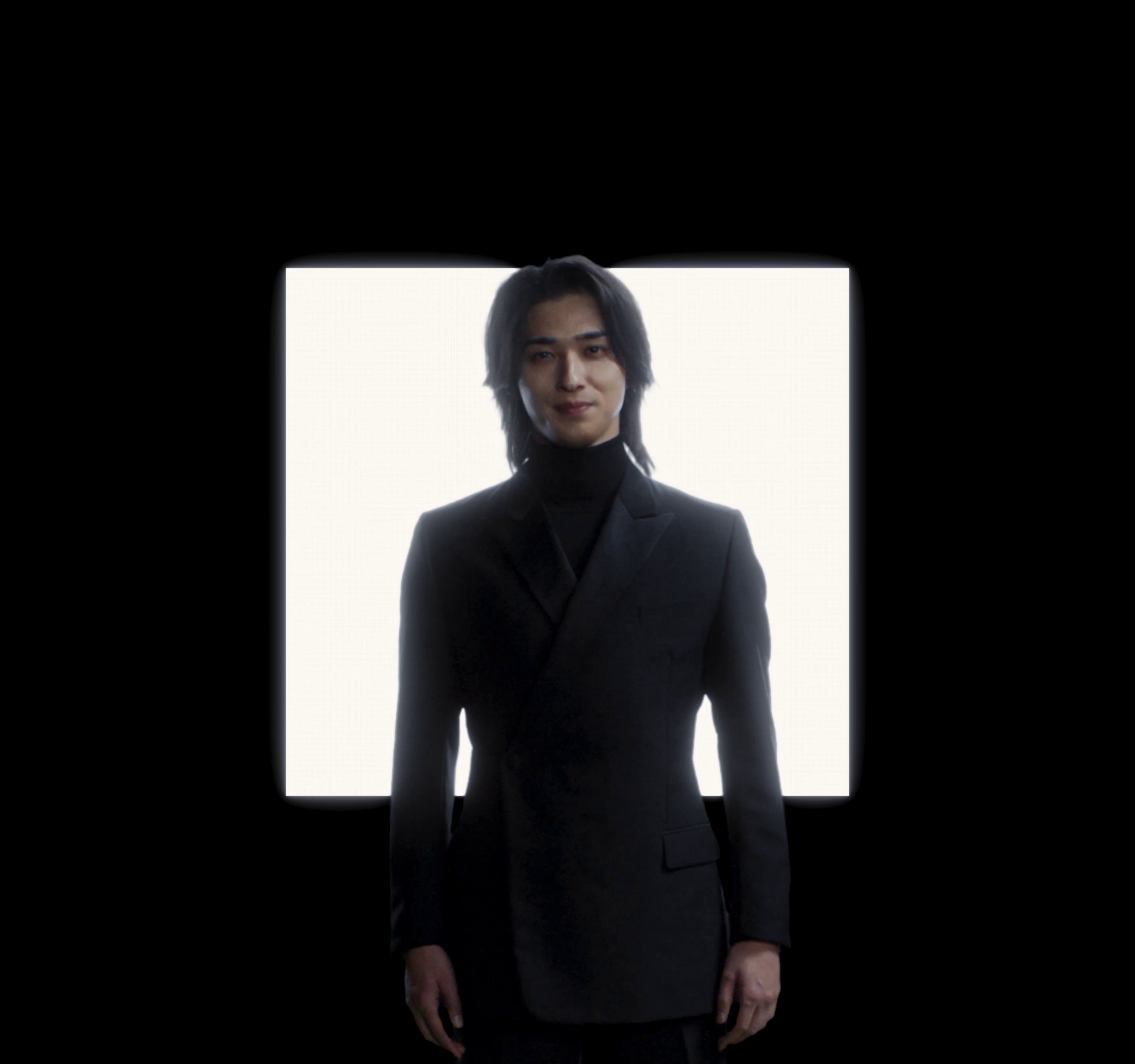ENGLISH
Immersive Theater on Neo-Japonism:
From Ancient Art to Anime
 Images are for illustrative purposes only.
Images are for illustrative purposes only.Explore Japanese Masterpieces
As Never Before on a Massive 7-Meter Screen
Anime Legends in Stunning Detail - Tezuka Osamu, Takahata Isao, and Hosoda Mamoru
A Superb Production Team Presents “Immersive Theater on Neo-Japonism: From Ancient Art to Anime”
The spectacular video production was made by the creative group, Panoramatiks, whose members possess expertise and experience in diverse fields including architecture, city, tourism and culture, and also CEKAI, a group of creators who have come together under the simple concept of “creating good things” and are active globally, including in Los Angeles and New York.
Music: Shuta Hasunuma (Musician, artist)
Presenter: Ryusei Yokohama (Actor)
Narrator: Rie Takahashi (Voice actor)
Overview
-
Dates
March 25–August 3, 2025
-
Venue
Room T5, Japanese Gallery (Honkan), Tokyo National Museum (Ueno Park)
-
Hours
9:30 a.m.–5:00 p.m.
Open until 8:00 p.m. on Fridays, Saturdays, May 4 (Sun.), May 5 (Mon.), and July 20 (Sun.)
Last entry 30 minutes to closing -
Closed
Mondays (except Mar. 31, Apr. 28, May 5, and Jul. 21), May 7 (Wed.), and July 22 (Tue.)
-
Organizers
Tokyo National Museum, NHK, NHK Promotions Inc.
-
Video Production
NHK Enterprises,Inc.
-
With the Cooperation of
Bridge Link Co., Ltd.
-
General Inquiries
+81-(0)50-5541-8600 (NTT Hello Dial Service)
-
Access
Tokyo National Museum

13-9 Ueno Park, Taito-ku, Tokyo, 110-8712, Japan
- JR Lines: 10-minute walk from Ueno or Uguisudani Station Tokyo
- Metro Lines: 15-minute walk from Ueno or Nezu Station
- Metro Lines: 15-minute walk from Ueno or Nezu Station
Outline/Subtitle
chapter1

Today, Japanese anime is popular with people around the world.
Neo-Japonism.
It is a phenomenon resonating around the world with the aesthetic sense inherited by the Japanese from a unique and rich cultural imagination that began over 10,000 years ago.
Together, let's take a look back at the origins of this Japanese aesthetic sense.

In the Jomon period.
Creative expressions flourished in Japan long before Christ.

A distinct aestheticism was budding.

Around the 3rd century ancient tomb building began.
Haniwa, or clay figurines, were arranged around the tombs.
They looked like this when they were made.
The color red was used to keep evil spirits away.
White was the color of purification.

Later, a Buddhist culture unique to this country blossomed.
It is distinguished by delicateness and grace.

In the era of civil war.
Warlords donned divine armor.



They loved performing arts that depicted the ever-changing world.
They were acutely aware that nothing is constant.


The Edo Period began in the 17th century.
A scene from Kyoto City, painted with a hope for peace.
It is extremely realistic and lively.

Wind God and Thunder God.
Prayers to nature and harmony with nature.
The idea of animism underpinned everything.
chapter2

Over its long history, Japan's unique aesthetic sense was expressed in diverse forms.
In the middle of the Edo Period,a culture for common people thrived.
A major influencer was Tsutaya Jūzaburō, who is the protagonist of NHK's historical drama "Berabou."
As a publishing producer, he built the foundations of Japanese pop culture.

Tsutaya Jūzaburō was also known as Tsutajū.
Tsutajū was very charismatic and attracted many talented people.
He then discovered brilliant artists such as Utamaro and Sharaku.

See the incredibly delicate details.

Powerful expression that captures a moment.
A distinct approach to realism.

And the unique attention to empty space.
chapter3

Ordinary folks shaped the culture, enjoying their lives and entertaining themselves.
This culture pleased the people of the time,was widely spread, and became very popular.
Over 100 years later, in the 20th century,a new type of pop culture evolved.
Japanese anime.

In the Taisho Period, the first Japanese anime was created.
"The Dull Sword"
It's Japan's oldest surviving anime film.
In the Showa Period, many masterpieces were born.
"Future Boy Conan."
Hayao Miyazaki made his directorial debut with this anime series.
During the Heisei Period, Japanese anime enjoyed success overseas.
The "Pokémon: Indigo League" TV anime series.
It was broadcast globally in over 190 countries and regions.
chapter4

Japanese anime is now very popular around the world.
It shares common qualities with Japan's traditional culture and aestheticism.
The last chapter of Immersive Theater explores the unique aesthetics underlying Japanese anime.

"Astro Boy."
The very first Japanese TV anime series, created by Osamu Tezuka.
He once remarked, "Animation is a kind of animism."
Anime arises from animism.
I mean, it's the art of breathing life into lifeless objects.
First, there's a non-living object,just a still sketch created using a brush.
But it begins moving as if alive, emitting sounds and colors.
It can move freely.
It can even be an impossible entity.

Animism reflects a distinct Japanese outlook on life.
Its symbolic representation is"Choju jinbutsu giga."
A rabbit splashes water.
Next to it, a rabbit holds her nose and dives backward.
This is clearly a human being.
Animals gradually turn into humans.
This is a true personifying caricature.

"The Tale of The Princess Kaguya" remains popular worldwide, over 10 years after its completion.
Director Isao Takahata once said, "Expressions similar to animation were already being used in the 12th century."
I think that manga and anime are rooted in works like the "Shigisan Engi Emaki,"which I think is the starting point, or the source.
"Shigisan Engi Emaki" is a pictorial scroll from the Heian Period.
It tells the tale of a monk who rebuilt a mountain temple in Nara.
Notable is its portrayal of time and movement, as shown in these flying rice sacks.

They most likely had fun looking at the scroll and being amazed at the changing scenes.
This is a unique characteristic of Japanese picture scrolls.
Artists had attempted this in the later half of the 12th century.
The viewer watches things progress over time, just like in a movie.
In that sense, it is truly cinematic.
And, because it consists of sketches,I believe that it is very anime-like.

Mamoru Hosoda directed "BELLE."
According to Hosoda, "The portrayal of characters in animation also has something in common with unique Japanese culture."
Characters' faces and figures are purposely portrayed in a simple fashion.
The artistic quality is achieved by avoiding drawing details.
The tradition of omitting is particularly prominent in Japanese art.
Hasegawa Tōhaku's "Pine Forest" is an example.

"Pine Forest," a Japanese national treasure,is a folding screen created in the 16th century.
It is one of the greatest masterpieces of ink painting.
It's a picture of a pine forest that emerges from the mist.
The picture, in essence, is mostly empty.
With this empty space, which is invisible due to the fog, the Japanese feel something deeper.
Perhaps it is something more than just a pine forest, or a profound emotion,or an existence that transcends humanity.
Japanese painting has a tradition of making use of omission and blank areas in its artistic expression.
Delicate depictions, animism, and use of empty space.
This unique aesthetic sense is still being passed down in Japanese life.
A 3-minute photo session will now begin.
Frequently asked questions
How much time is needed to view the exhibition?
The exhibition is structured to take a total time of approximately 24 minutes, including around 21 minutes for the video and about 3 minutes for the photo time. As the same video is shown repeatedly, you may enter and leave the exhibition space freely.
Is the exhibition enjoyable for people of all ages? (Young children, the elderly)
As this exhibition features a video which traces the beauty of Japan from ancient times to the present day, it can be enjoyed by people of all ages. Adults can enjoy the narrative of the video while children can enjoy watching artworks on a large screen which are usually not easily accessible for viewing.
However, certain parts of the video include movement. We advise individuals who tend to feel motion sickness to take precautions and to sit down while watching the video. Moreover, as the exhibition space is dark, please keep an eye on your children.
Are there subtitles in Japanese or in a foreign language?
In addition to a narration in Japanese, the exhibition will provide subtitles in Japanese and English.
The English subtitles will appear facing on the front left-hand side of the large monitor and the Japanese subtitles will appear on the front right-hand side.
When viewing the subtitles, we advise you to stand near the corresponding monitor.
Will it be possible to enjoy the exhibition with a wheelchair or stroller?
The exhibition can be enjoyed by wheelchair users. You may also enter the exhibition with a stroller but please be careful since it is dark inside the exhibition space. However, when the exhibition is crowded, we may not allow strollers to enter inside in order to ensure the safety of the children.
Is it possible to take photographs and videos inside the exhibition space? Is posting on social media allowed?
Only photographs can be taken inside the exhibition space. We provide a photo time (3 minutes) at the end of the video. Please enjoy taking photographs inside the video space. Please also freely post on social media. When taking photographs, please be careful not to collide with other viewers, the monitors or walls.
*Video recordings are not allowed.
*The use of flash-photography, monopods, or tripods is not allowed.
What will the experience be like?
You will walk through a tunnel-like passage when entering and exiting the exhibition. The central large exhibition room (one room) will feature monitors on all four sides for viewing. You will not be asked to wear something nor will you experience any bodily sensations such as vibrations. You will not have to move through several rooms.
Will the content of the exhibition change during the exhibition period?
Please understand that we may have to change parts of the video when taking into consideration overcrowded situations and ease of viewing for visitors.
Regarding Tickets
Do the tickets have a designated date and time?
No, the tickets do not have a designated date and time. *You may have to wait when it is crowded.
Moreover, there may be changes in the operational procedures. Please check the official website for the latest information before visiting the exhibition.
From what age do you need to purchase exhibition tickets?
High school students and above need to purchase a ticket. Middle school students and below, persons with disabilities and one caregiver accompanying the individual may enter free of charge. Please show your student ID and disability certificate when entering the museum.
Is it possible to cancel tickets?
Once you have purchased your ticket, you will not be able to change your ticket type, receive a refund or have your ticket reissued.
Can tickets be purchased on the day of the visit?
Tickets can be purchased on the day of your visit through the various ticket websites. Tickets can also be purchased at the museum ticket office. However, we advise you to purchase your tickets beforehand since the museum ticket office is especially busy on weekends and holidays, and you may have to wait in line for a while.
Is it possible to enter the exhibition as a group?
Yes, it is possible, but we do not offer group exhibition tickets or group reservations. When the exhibition is crowded, your group may not be able to enter together at the same time and may have to be split into different screening times.
Will we be able to view other exhibitions at the Tokyo National Museum?
You will be able to view the Tokyo National Museum Collection Exhibition with your ticket if it is on the same day.
Are the viewers required to exit the exhibition space after each screening?
No, we do not require you to leave the exhibition space after each screening. *Operational procedures may change when it is crowded.
Is it possible to watch the video continuously?
As you are not required to leave the exhibition space after each screening, you will be able to watch the video continuously, including if you enter the room in the middle of a screening. *Operational procedures may change when it is crowded.
Is it possible to reenter the exhibition space?
Yes, you may reenter the exhibition space if it is on the same day. However, you may have to wait if it is crowded.
Are there seats so we can sit down while watching the video?
We have some chairs set out inside the exhibition space. However, please be aware that we may have to adjust the number of seats available depending on how crowded it is inside the room.
Is it possible to eat or drink inside the exhibition space?
Please refrain from eating or drinking inside the exhibition space. Moreover, please limit any eating or drinking to the designated areas within the museum.
Are there any restrictions for watching the video?
For safety reasons, our staff may approach the following persons listed below before they enter the exhibition space.
Children unaccompanied by an adult
Individuals who feel unwell
Individuals who are wearing excessively high-heeled shoes (stilettos, platform shoes, Japanese wooden clogs)
Other individuals who the staff may judge as being unable to watch the video safely
Is it dark inside the exhibition space?
Although the large LED monitor will be displaying a video, please ensure that you watch your step as the exhibition room is only dimly lit. Please keep young children by your side.
Will individuals who are sensitive to light and sound be able to enjoy the video?
We do not use special light effects but viewers will be watching a video on large LED monitors.
The monitor positioned in the front is especially large (7×7 meters) and may appear brighter.
Certain sections of the video also contain movement. To enhance the viewer’s immersive experience inside the exhibition space, we use several speakers to create a stereo sound. As a result, you may feel the effects of a closer and more real experience coming from the direction of the sound.
Please contact staff members if you feel unwell.
Precautions
Please refrain from having conversations inside the exhibition space in order to avoid disturbing the other viewers.
Please do not lean against walls or the monitors. Please do not touch the monitors.
Please refrain from wearing shoes such as stilettos and Japanese wooden clogs which can make excessive noise.
Please refrain from having conversations on your mobile phone.
Please follow the instructions of the staff when inside the exhibition space.
